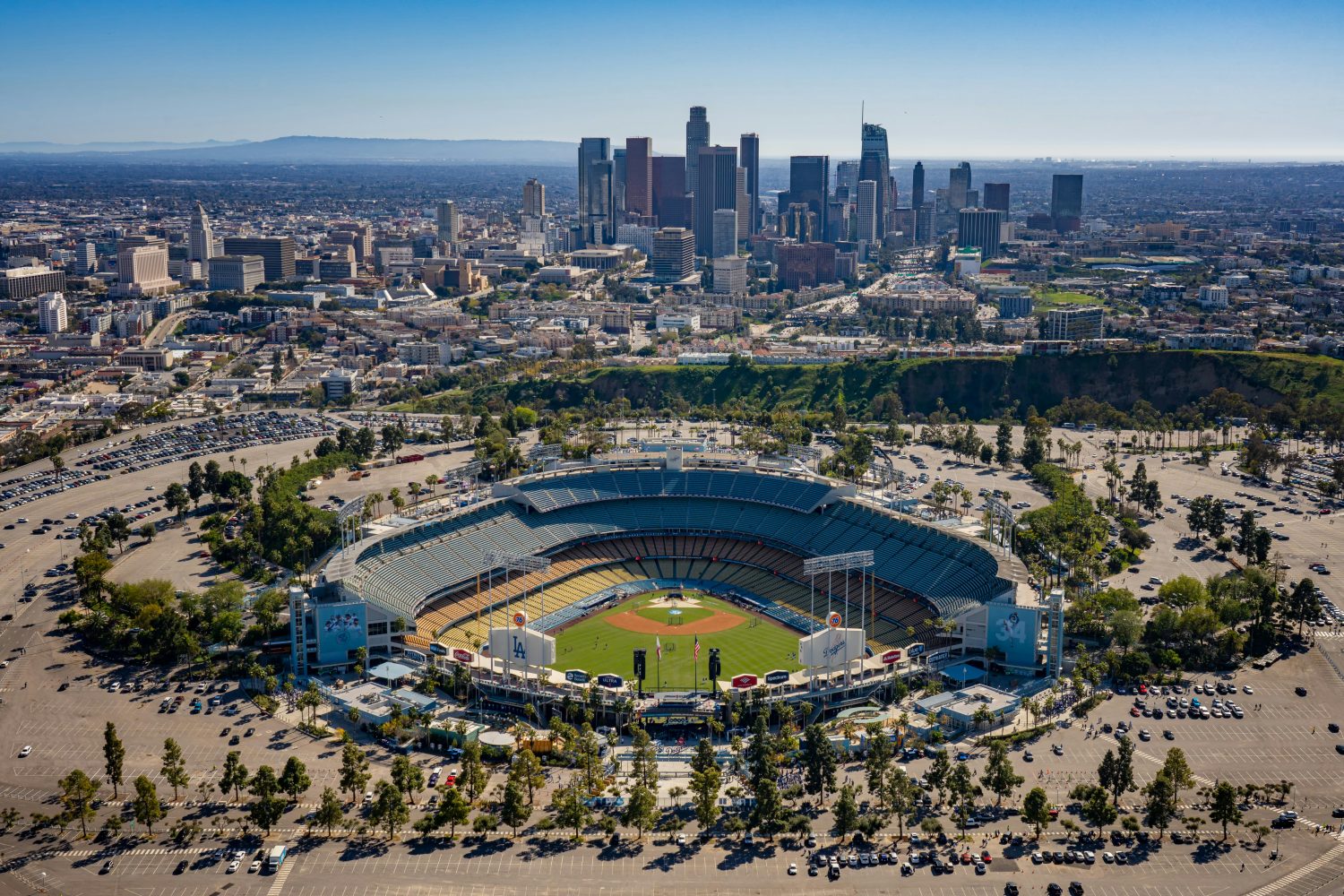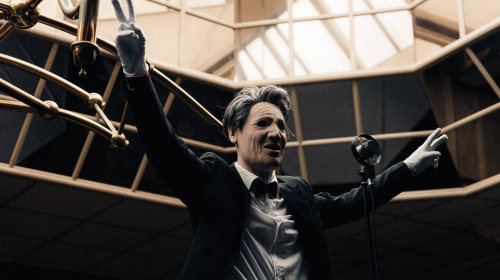Baseball stadiums aren’t just places where games happen — they’re cultural landmarks, food hubs, and symbols of entire cities. The experience of a ballpark is shaped by its location, its fans, the food, the views, and its history. Some stadiums feel like baseball cathedrals that every fan should see at least once, while others feel like they were outdated the day they opened.
The Major League Baseball ballpark experience is about more than just the game on the field. It’s the roar of the crowd, the signature dishes at concessions, the skyline views beyond the outfield, and the traditions that fans bring with them year after year. Since I haven’t been to all of these baseball stadiums personally — only T-Mobile Park in Seattle and Dodger Stadium in Los Angeles— this ranking is built from online reviews, stadium reputations, fan culture, and the way each park fits into MLB history.
Major League Baseball Stadiums Ranked 2025
30. Oakland Coliseum (Oakland Athletics – soon Las Vegas Athletics)
Opened in 1966, the Coliseum has been one of the most infamous stadiums in all professional sports. Sewage leaks, broken seats, outdated concourses, and a concrete-heavy design make it feel more like an abandoned warehouse than a ballpark.
Fans do give credit to the loyal A’s and Raiders faithful for tailgating and bringing their own energy, but the stadium itself has long been described as depressing. Even during the team’s competitive years, the Coliseum felt half-empty. Concession options are minimal and overpriced, and online reviews consistently rank it dead last.
The A’s decision to relocate to Las Vegas puts the final nail in the Coliseum’s coffin. The upcoming Strip-side ballpark will be flashy, modern, and built for entertainment — the exact opposite of what Oakland fans have endured for decades.
29. Tropicana Field (Tampa Bay Rays)
Built in 1990, Tropicana Field — “The Trop” — has been widely criticized since day one. It’s one of the last true domes in MLB, but instead of feeling futuristic, it feels sterile and lifeless. The turf, the catwalks that interfere with play, and the warehouse lighting make it a tough sell even for devoted Rays fans.
The location in St. Petersburg makes attendance tough, with fans often complaining about long commutes from Tampa. Food offerings are serviceable, but nothing sets them apart compared to MLB’s top stadiums. Even with a competitive team on the field, The Trop struggles to generate atmosphere.
The Rays have teased new stadium plans for years. Until something changes, Tropicana Field will stay near the bottom of every list.
28. Guaranteed Rate Field (Chicago White Sox)
When it opened in 1991 to replace the legendary Comiskey Park, White Sox fans hoped for a modern classic. Instead, Guaranteed Rate Field ended up with a reputation for being bland and concrete-heavy, a product of 1990s design that lacked charm.
The neighborhood doesn’t compare to Wrigleyville across town, and online reviews describe the atmosphere as lifeless unless the Sox are in the playoffs. Food options — like Italian beef sandwiches and deep-dish pizza — are solid, but the overall stadium experience is still underwhelming.
Even with renovations, it doesn’t feel like a must-visit ballpark.
27. Rogers Centre (Toronto Blue Jays)
Originally opened as SkyDome in 1989, Rogers Centre was once a marvel with its retractable roof and hotel rooms overlooking the field. But decades later, it feels more like a giant concrete box.
While the downtown location is a plus, the atmosphere often feels flat compared to MLB’s more intimate stadiums. Concessions have improved in recent years, with Canadian touches like poutine and craft beer, but reviews still describe it as outdated.
Renovations are currently underway, and Blue Jays fans hope the upgrades will finally give their ballpark the energy it deserves.
26. Chase Field (Arizona Diamondbacks)
Opened in 1998 with the unique gimmick of a swimming pool in right-center field, Chase Field has always leaned into novelty. The retractable roof and AC are lifesavers in Phoenix heat, but the ballpark itself often feels sterile.
Fans say the atmosphere rarely gets electric unless it’s postseason baseball. The food lineup has improved, with Sonoran hot dogs and southwestern fare, but the stadium is still viewed as generic compared to others.
25. Nationals Park (Washington Nationals)
Opened in 2008, Nationals Park is clean, modern, and centrally located in D.C. — but fans routinely describe it as “cookie-cutter.”
Concessions lean into regional staples like half-smokes, crab cakes, and craft beer, which elevate the food experience. The neighborhood around the stadium has grown into a destination, with bars and restaurants adding life on game days. Still, compared to iconic or newer ballparks, it lacks identity.
24. Great American Ball Park (Cincinnati Reds)
Since opening in 2003, Great American Ball Park has been serviceable but rarely cracks top rankings. Fans appreciate the Ohio River backdrop and nods to Reds history, but online reviews call out parking issues, average concessions, and underwhelming atmosphere.
Skyline Chili dogs are a must-try, but beyond that, food and drink don’t stand out. Unless the Reds are competitive, the energy often feels flat.
23. Comerica Park (Detroit Tigers)
Opened in 2000, Comerica Park is massive, with tiger statues, a Ferris wheel, and even a carousel. While the extras are fun, fans often say the stadium lacks soul.
Food offerings include Detroit-style pizza, Coney dogs, and craft beer, which help the experience. But unless the Tigers are playing well, the atmosphere feels hollow for such a large venue.
22. LoanDepot Park (Miami Marlins)
Built in 2012 with a retractable roof and modern design, LoanDepot Park looks the part but struggles with identity. Fans describe it as flashy but empty, often because attendance is among the lowest in MLB.
Features like a nightclub and fish tanks drew early attention but have failed to create long-term culture. Cuban food offerings stand out, but the overall experience is more spectacle than tradition.
21. Minute Maid Park (Houston Astros)
Opened in 2000, Minute Maid Park is famous for its retractable roof and the train that runs along the left-field wall. Fans enjoy the comfort in Houston heat, but some call the ballpark gimmicky.
Food options include Tex-Mex staples, barbecue, and plenty of beer, which keep fans satisfied. Postseason games here are loud and intense, but during the regular season, it can feel corporate.
Major League Baseball Stadiums Ranked 2025
20. Busch Stadium (St. Louis Cardinals)
The third version of Busch Stadium opened in 2006, bringing great views of the Gateway Arch and a clean design. Cardinals Nation fills the stands consistently, making the vibe strong on game days.
Food options include toasted ravioli and barbecue, both local favorites. Still, compared to MLB’s elite stadiums, Busch feels solid but unspectacular.
19. Citizens Bank Park (Philadelphia Phillies)
Opened in 2004, Citizens Bank Park is fueled by the intensity of Philly fans. The atmosphere is lively and often intimidating for opponents.
Food is a major strength, with cheesesteaks, crab fries, and a growing craft beer scene. Fans online often describe it as a good ballpark that lacks the wow factor of MLB’s best.
18. Target Field (Minnesota Twins)
Opened in 2010, Target Field brought the Twins back outdoors in a beautiful downtown location with skyline views. Fans love the design, calling it one of the cleanest ballparks in baseball.
The food is standout, featuring Juicy Lucy burgers, walleye sandwiches, and Minnesota craft beer. The main drawback is the weather — cold early-season games can be rough.
17. Coors Field (Colorado Rockies)
Since 1995, Coors Field has been known as a hitter’s paradise thanks to Denver’s altitude. Home runs fly out, and fans love the offensive fireworks.
The rooftop deck is a fan favorite for socializing, with one of the best craft beer selections in MLB. Its location in LoDo makes it perfect for pre- and post-game energy.
16. Petco Park (San Diego Padres)
Opened in 2004, Petco Park is one of the most scenic stadiums in MLB, located downtown with bay views. Fans describe it as laid back but fun, especially with the Padres’ recent resurgence.
Food is elite here, with fish tacos, carne asada fries, and San Diego craft beer leading the way. While the vibe is more relaxed than electric, it’s still one of MLB’s most enjoyable ballparks.
15. Yankee Stadium (New York Yankees)
The new Yankee Stadium opened in 2009, replacing one of baseball’s most historic venues. It’s massive and luxurious, but many fans argue it lacks the character of the old stadium.
Food includes Lobel’s steak sandwiches, garlic fries, and plenty of New York staples. Monument Park preserves history, but reviews often call it more corporate than soulful.
14. Citi Field (New York Mets)
Opened in 2009, Citi Field quickly became known for having some of the best food in baseball — Shake Shack, Pat LaFrieda steak sandwiches, and dozens of local vendors.
Mets fans bring an unmatched chaos, making it one of the more entertaining fan experiences. While the location in Queens isn’t glamorous, the stadium itself delivers across the board.
13. Fenway Park (Boston Red Sox)
Since 1912, Fenway Park has stood as MLB’s oldest and most iconic stadium. The Green Monster, Pesky Pole, and quirky layout make it legendary.
Fans note real drawbacks: cramped seating, obstructed views, and sky-high prices. But the atmosphere and history make it a must-visit stadium regardless of the flaws.
12. Dodger Stadium (Los Angeles Dodgers)
Opened in 1962, Dodger Stadium is the largest stadium in MLB, holding over 56,000 fans. Nestled in Chavez Ravine, it offers unmatched views of the San Gabriel Mountains and LA sunsets.
Game-day atmosphere is intense, with a mix of diehard locals and celebrities in the crowd. The postseason noise is deafening, creating one of the most intimidating environments in baseball.
Food goes beyond Dodger Dogs — fans rave about micheladas, elote, tacos, BBQ, and vegan options. Recent renovations modernized the concourses without erasing tradition. Online reviews confirm Dodger Stadium as one of the world’s true baseball cathedrals.
11. Globe Life Field (Texas Rangers)
Opened in 2020, Globe Life Field is one of MLB’s newest venues and already a fan favorite. The retractable roof and air conditioning make Texas summers bearable.
Food includes barbecue, massive Texas-sized portions, and plenty of craft beer. Reviews highlight the comfort, modern design, and big-game atmosphere.
10. Oracle Park (San Francisco Giants)
Since opening in 2000, Oracle Park has been praised as one of baseball’s most scenic venues. McCovey Cove, visible beyond right field, has become iconic as kayaks chase home run balls.
Garlic fries are a fan favorite, alongside clam chowder in sourdough bowls and Bay Area craft beer. Giants fans keep the atmosphere lively, and the views make it unforgettable.
9. Wrigley Field (Chicago Cubs)
Opened in 1914, Wrigley Field is baseball’s church. The ivy-covered outfield walls, manual scoreboard, and Wrigleyville neighborhood make it one of the sport’s greatest traditions.
Fans deal with cramped seating and limited amenities, but nobody cares. The atmosphere and history make Wrigley a bucket-list destination for any baseball fan.
8. Progressive Field (Cleveland Guardians)
Opened in 1994, Progressive Field has aged well thanks to renovations that modernized concourses and amenities.
Affordable food, like dollar dog nights, makes it one of the most family-friendly ballparks. The intimate feel and passionate fans make this an underrated gem.
7. PNC Park (Pittsburgh Pirates)
Opened in 2001, PNC Park is widely considered the most beautiful stadium in MLB. The skyline and Roberto Clemente Bridge beyond the outfield make it a postcard backdrop.
Food includes pierogis, Primanti Bros sandwiches, and craft beer. Even with a struggling team, reviews consistently rank PNC as one of the best game-day experiences.
6. American Family Field (Milwaukee Brewers)
Opened in 2001 with a retractable roof, American Family Field is famous for its tailgating culture. Fans grill brats and drink beer in the parking lot before every game.
Inside, food highlights include sausages, cheese curds, and local Wisconsin beer. The racing sausages are a fan tradition, and the atmosphere is consistently fun.
5. T-Mobile Park (Seattle Mariners)
Opened in 1999, T-Mobile Park blends modern design with Pacific Northwest flavor. The retractable roof keeps out the rain without killing the outdoor vibe.
Food is among the best in MLB — sushi, clam chowder, crab sandwiches, and fresh seafood. Fans bring noise, and when the Mariners are winning, it’s one of the loudest stadiums in the league.
4. Truist Park (Atlanta Braves)
Opened in 2017, Truist Park is paired with The Battery — an entertainment district of bars, restaurants, and shops that make it a full-day experience.
Southern-inspired food dominates concessions, and Braves fans fill the stands with energy. Playoff games here are electric, making it one of MLB’s best modern venues.
3. Camden Yards (Baltimore Orioles)
Opened in 1992, Camden Yards revolutionized stadium design by introducing the retro-modern look that many others copied. The brick warehouse beyond right field is iconic.
Food includes crab cakes, Old Bay fries, and local brews. Orioles fans describe it as one of the best atmospheres in baseball, especially with the team’s recent resurgence.
2. The Future Las Vegas Ballpark (Athletics)
With the A’s leaving Oakland, MLB is gaining what could become one of the league’s premier stadiums. Plans for a new ballpark on the Las Vegas Strip include luxury suites, modern amenities, and entertainment-first design.
Think Allegiant Stadium but for baseball: flashy, bold, and built to capture both locals and tourists. Once it opens, this park will instantly compete for the top spot in any MLB stadium ranking.
1. Dodger Stadium (Los Angeles Dodgers)
Yes, Dodger Stadium deserves two entries — because it’s still the king. Between the views, the history, the food, the fans, and the modern upgrades, it’s the most complete ballpark in MLB.
From Vin Scully’s legendary broadcasts to Kirk Gibson’s home run to World Series nights under the LA lights, Dodger Stadium has seen it all. Reviews consistently place it at the top for atmosphere, and no stadium blends tradition with entertainment better.
⚾ MLB Stadium Rankings FAQ
What is the worst MLB stadium in 2025?
The Oakland Coliseum takes the bottom spot. Its outdated design and lack of upkeep drove the A’s to relocate to Las Vegas.
What is the best MLB stadium?
Dodger Stadium currently sits at #1, with Camden Yards, PNC Park, and Truist Park all close behind.
Which stadiums are being replaced?
The A’s new Las Vegas ballpark is set to replace Oakland Coliseum, while Rogers Centre and Tropicana Field are both undergoing or planning major changes.
What’s the oldest MLB stadium?
Fenway Park (1912) and Wrigley Field (1914).
Newest stadium?
Globe Life Field (2020).
Which stadium has the best food?
Citi Field, Oracle Park, and T-Mobile Park consistently get top reviews for ballpark eats.
Which stadium has the best view?
PNC Park in Pittsburgh and Oracle Park in San Francisco lead the way.
What stadium has the largest capacity?
Dodger Stadium at over 56,000.
Smallest?
Progressive Field and Tropicana Field hover around 30,000–35,000.
Best family-friendly stadiums?
Petco Park and T-Mobile Park.
Best tailgating?
American Family Field in Milwaukee.
What makes the Vegas stadium special?
It’s expected to be baseball’s most entertainment-focused venue, blending MLB with Las Vegas nightlife and tourism.
Which stadiums are bucket-list ballparks for fans?
Fenway Park, Wrigley Field, Dodger Stadium, Oracle Park, and PNC Park.
Which stadiums are considered overrated?
Yankee Stadium, Tropicana Field, and Minute Maid Park get mentioned as overrated compared to fan expectations.
Which ballparks are most affordable?
Progressive Field and American Family Field offer cheap food and ticket deals.
What’s the loudest stadium in MLB?
T-Mobile Park and Citizens Bank Park are among the loudest, with playoff energy reaching NFL-level noise.
Do retractable roofs improve the experience?
Yes — stadiums like T-Mobile Park, Globe Life Field, and Minute Maid Park show how a roof can balance weather control with atmosphere.
Major League Baseball stadiums are more than concrete and steel — they’re living parts of the game’s culture. Every ballpark tells a story about its city, its fans, and the way baseball is experienced across America. From the gritty charm of Fenway Park and Wrigley Field to the luxury of Dodger Stadium and the futuristic energy of Globe Life Field, no two stadiums are the same.
Some parks, like the Oakland Coliseum and Tropicana Field, remind us that not every stadium can stand the test of time. Others, like PNC Park, Oracle Park, and Camden Yards, prove that when great design, amazing food, and passionate fan culture come together, you get ballparks that people travel across the country to experience.
The future of MLB stadiums is also exciting. The upcoming Las Vegas Athletics ballpark will push the boundaries of what a baseball venue can be, merging the spectacle of the Strip with the traditions of America’s pastime. Just like Truist Park’s Battery District changed the way fans experience game day, Las Vegas is ready to redefine baseball entertainment altogether.







